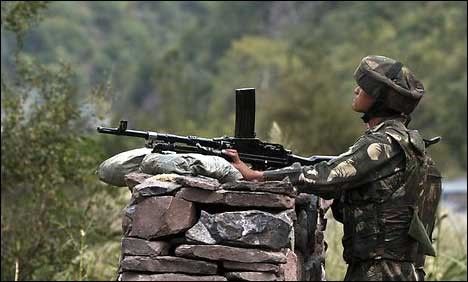 Attempts to infiltrate into Jammu and Kashmir intensify usually in the autumn, marking, to some extent, the desperation to keep the strength of hardcore, committed militants at a sufficient high. 95 militants infiltrated in 2010, 52 in 2011 and 121 in 2012. For the first time after some years, in 2012 and 2013, new infiltrants numbered more than those neutralised. Attrition during the last few years had brought down the number of militants in J&K from the benchmark of 3200-3500 to as low as less than 50. Ceasefire violations too have risen recently. While not overly alarming in themselves, the 27 September attacks on Hiranagar police station and a rather inadequately guarded Army camp in Samba, on the eve of the Prime Ministerial level talks in New York, underline the dangers of complacency in this regard.
Attempts to infiltrate into Jammu and Kashmir intensify usually in the autumn, marking, to some extent, the desperation to keep the strength of hardcore, committed militants at a sufficient high. 95 militants infiltrated in 2010, 52 in 2011 and 121 in 2012. For the first time after some years, in 2012 and 2013, new infiltrants numbered more than those neutralised. Attrition during the last few years had brought down the number of militants in J&K from the benchmark of 3200-3500 to as low as less than 50. Ceasefire violations too have risen recently. While not overly alarming in themselves, the 27 September attacks on Hiranagar police station and a rather inadequately guarded Army camp in Samba, on the eve of the Prime Ministerial level talks in New York, underline the dangers of complacency in this regard.
The aim of the Keran intrusions may have been to revive a base of hardened terrorists who could reach into the densely forested safe havens of Rajwar, Hafruda and the Lolab valley, near Kupwara. In time, they could form the nucleus of a larger force, if circumstances develop favourably after US force withdrawals from Afghanistan in 2014 and a `peace stalemate’ with the Pakistan Taliban in the Federally Administered Tribal Areas (FATA) permits diverting idle terrorists from the western front.
More significantly, the new brands of infiltrants coming across are much better trained, well equipped and battle-hardened. They not only had accurate data about the gulleys and nullahs in this difficult Shamshabari terrain but seemed well aware of precise Indian military post locations and troop strengths deployed in the 15 Corps northern grid. This knowledge could not have been obtained by any rag tag outfit of infiltrators without assistance of serving military personnel on the other side. Similar guidance must have been given during initial training in LeT’s camps in Malakand, Khyber Paktunkhwa and elsewhere in Punjab, at Pakistan Military Intelligence’s staging posts near the Line of Control (LoC) and by Inter Services Intelligence’s (ISI) Joint Intelligence, North (JIN) handlers. None of this is new though.
Howsoever gruesome the incident along the LoC, the Pakistan Army is quick to issue customary denials about its involvement. Leave aside dismantling its terror apparatus, it does not see any need to give up its asymmetric power enhancement option, that of using the so-called `good’ non-state actors, who do not attack their own establishment. These include the Lashkar e Taiba (LeT), Jaish e Mohammad (JeM) and Hizbul Mujahideen (HM).
LeT remains flush with funds, some generously endowed by the Shahbaz Sharif Punjab administration, ostensibly for benevolent educational reforms! Apart from sustaining a ready band of ideologically motivated, unemployed or unemployable youth trained in their own ` factories' in Muridke and Balakot, the LeT still retains the ability to recruit ideologically motivated ethnic Kashmiri cadres inside J&K. The Jaish has strongholds in South Punjab where they ally with sectarian groups like Lashkar e Jhangvi (LeJ). These outfits have also not given up their programme of building multiple cells under cover, appealing to alienated youth wherever local irritants exacerbate tension, as was witnessed recently in Kishtwar. Their linkages with Indian Mujahideen remain potent.
As long as this fundamental approach to achieve tactical or strategic objectives does not change, it would be naïve to expect any mechanism of joint inter-action between the Directors General of Military Operations of the two Armies to provide succour, either as short term redress for any specific incidents or to prevent recurring ceasefire violations. At best, bringing together senior, serving military officers of both countries intermittently or under a regular time frame may help lower the trust deficit between the two armies, especially if this process is allowed to percolate downwards – to the Brigade or Battalion command levels. The Pakistani Army is unlikely to be too forthcoming.
In both countries, the political situation remains beset with uncertainties. India will be facing elections in the states and at the centre, even in Jammu and Kashmir later next year, where clear or decisive mandates for governance may not emerge. In Pakistan’s own backyard, though Nawaz Sharif’s PML (N) won a comfortable majority in the National Assembly, it has made heavy weather of moving ahead, either in the peace dialogue with the Taliban or in making important executive appointments like the Chairman, Joint Chiefs of Staff Committee, the Army Chief and Pakistan’s Ambassador to the US. Nawaz Sharif remains rather diffident and apprehensive of asserting authority this time.
In any case, the Army will not let him take over the policy agenda on Kashmir or bilateral relations with India at present. Till we detect any incremental changes in this equation, the need of the hour would be not to lower guard, and enhance our capabilities, both for better defence and deniable covert ripostes, where these hurt most.
Courtesy : Institute of Peace and Conflict Studies (http://www.ipcs.org)